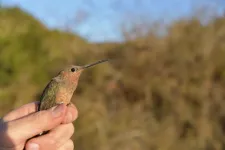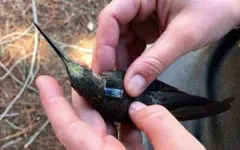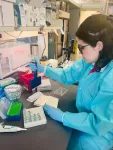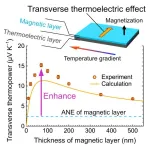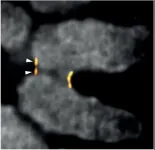(Press-News.org) Researchers from UNM’s Museum of Southwestern Biology (MSB) have uncovered the giant hummingbird’s extreme long-distance migration for the first time. Their eight-year study, Extreme elevational migration spurred cryptic speciation in giant hummingbirds published this week in Proceedings of the National Academy of Sciences, led them to another important discovery: The world’s largest hummingbird is a new species.
The team, led by Jessie Williamson, UNM Ph.D., 2022, included the Museum of Southwestern Biology at UNM, Pontificia Universidad Católica de Chile in Chile, and Centro de Ornitología y Biodiversidad in Peru. Initially the researchers wanted to figure out where these migratory giant hummingbirds spend the winter. The birds, which are about eight times the size of a Black-chinned hummingbird, breed along the Pacific Coasts of central Chile but ‘vanish’ after breeding. This mystery had remained unsolved since the 19th century when Charles Darwin observed the migratory giant hummingbirds during his voyage on The Beagle. At that time, Darwin speculated that the hummingbirds migrated to the Atacama Desert region of northern Chile.
By affixing miniature backpacks tracking devices to hummingbirds, Williamson and her UNM-led team of international collaborators discovered that migratory giant hummingbirds ascend over 13,000 feet in elevation to the high Andes, flying as far north as the mountains of Peru. This roundtrip migratory journey covers more than 5,200 miles –– about the distance between New York City and Buenos Aires.
To make the discovery, Williamson developed a method for attaching miniature ‘backpack’ tracking devices that were small and light enough for hummingbirds and did not interfere with their hovering style of flight. She published a paper describing this method in the Journal of Avian Biology in 2021.
“It took a lot of trial and error to come up with a suitable harness design,” said Williamson. “Hummingbirds are challenging to work with because they are lightweight with long wings and short legs. They’re nature’s tiny acrobats.”
One of the research team's novel discoveries was that migratory giant hummingbirds don’t just fly straight up to high altitudes–they pause their upward climb for periods of days to allow their blood and lungs to acclimate. In this way, the giant hummingbirds employ the same acclimatization strategy used by human mountaineers.
“Nobody had figured out where migratory giant hummingbirds go because they were hiding among the non-migratory giant hummingbirds,” said Professor and Director of the Museum of Southwestern Biology Christopher Witt, who advised Williamson’s dissertation work. “The two forms of giant hummingbird look almost identical — for centuries, ornithologists and birders never noticed that they were different. “We couldn’t have figured this out without the miniaturized trackers.”
Genome sequencing of museum specimens allowed the team to distinguish the two forms of giant hummingbirds for the first time.
“Natural history collections were absolutely essential to this work,” said co-author Ethan Gyllenhaal, a current Ph.D. candidate at UNM. “Including DNA from 154-year-old type specimens was key to solving this evolutionary puzzle.”
In fact, these valuable historic specimens led the team to the groundbreaking finding that the migratory and high-elevation resident giant hummingbirds had been evolving separately for about three million years, more than enough time to make them distinct species.
The giant hummingbird population that lives year-round in the high Andes is larger and has notably different blood and lungs than the migratory form. As a previously unrecognized species (Patagona sp. nov.), it needed a name. After consulting with scholars, the team proposed the name Patagona chaski to recognize the shared characteristics between giant hummingbirds and the high-altitude adapted, fleet-footed chaski messengers of the Inka empire.
This work was made possible through international collaborations among institutions in the United States, Chile, and Peru and supported by generous landowners in Chile and rural communities in Peru. The team of authors, students and field assistants, conducted dedicated fieldwork from sea level to high Andean peaks. In Chile, the team succeeded in capturing a giant hummingbird only once every 146 net hours. Field crews camped and worked on steep, cactus-laden Andean slopes with no electricity or running water for weeks at a time.
“This effort is just the beginning,” said Williamson, “Combining migration tracking with genomics has opened up research opportunities that could fill a lifetime.”
UNM Research Team: The team from UNM’s Museum of Southwestern Biology included Dr. Jessie Williamson (UNM Ph.D., 2022), who led this work as part of her dissertation, and her advisor, Dr. Christopher C. Witt. Dr. Williamson is currently a National Science Foundation Postdoctoral Fellow and Rose Fellow at the Cornell Lab of Ornithology; she also continues as a Research Associate at the Museum of Southwestern Biology; in August, 2025, she will be an Assistant Professor of Zoology and Physiology at the University of Wyoming. Other team members included Selina Bauernfeind (UNM B.S. 2016, M.S. 2022), Matthew Baumann (UNM B.S., 2010, M.S. 2014), Chauncey Gadek (UNM B.S., 2016, M.S., 2019), and Ethan Gyllenhaal (UNM Ph.D., 2024).
Other collaborating institutions: Universidad Pontificia Católica de Chile, Centro de Ornitología y Biodiversidad, George Washington University, University of Oregon, and Cornell University & Lab of Ornithology.
Funding: National Science Foundation, Dr. Mike Hartshorne and Dr. Lida Crooks, American Philosophical Society, Explorers Club, Society of Systematic Biologists, American Ornithological Society, Wilson Ornithological Society, Nuttall Ornithological Club, American Museum of Natural History, UNM Biology Graduate Student Association, UNM Latin American and Iberian Institute, and UNM Department of Biology Scholarships.
Contact: For further information, please contact Christopher C. Witt
Email: cwitt@unm.edu
Phone: +1 505-918-7199
Source: Williamson JL, Gyllenhaal EF, Bauernfeind SM, Bautista E, Baumann MJ, Gadek CR, Marra PP, Ricote N, Valqui T, Bozinovic F, Singh ND, Witt CC. 2024. Extreme elevational migration spurred cryptic speciation in giant hummingbirds. Proceedings of the National Academy of Sciences. https://doi.org/10.1073/pnas.2313599121
END
How miniature backpacks led to the discovery of the world’s largest hummingbird species
Eight year University of New Mexico study leads to new species
2024-05-13
ELSE PRESS RELEASES FROM THIS DATE:
New synthetic biomarker technology differentiates between prior Zika and dengue infections
2024-05-13
A newly discovered Zika virus-specific synthetic molecule is capable of differentiating Zika-immune patient samples from samples of patients previously infected with the related dengue virus. The technology may lead to the development of better diagnostics and vaccine candidates, scientists announced today in the Proceedings of the National Academy of Sciences.
The study, led by researchers at the University of Pittsburgh School of Public Health and The Herbert Wertheim UF Scripps Institute for Biomedical Innovation & Technology, is the first to apply an innovative “epitope surrogate” technology to Zika. Until now, researchers and clinicians have lacked diagnostic ...
Fruit fly testes offer potential tool against harmful insects
2024-05-13
A way to curb nagging insects has been flying under our radar—an enzyme from fruit fly testes.
The compound could control bugs that carry disease and harm crops by stunting their ability to procreate, Johns Hopkins University researchers found.
“We have a toe in the door to control fruit fly populations with this enzyme,” said Steven Rokita, a professor of chemistry at Johns Hopkins who led the research. “It could offer a good way to control fertility of all kinds of biological and agricultural pests, starting with mosquito populations.”
The findings are set to publish ...
Exceptionally large transverse thermoelectric effect produced by combining thermoelectric and magnetic materials
2024-05-13
1. A NIMS research team has demonstrated for the first time ever that a simple stack of thermoelectric and magnetic material layers can exhibit a substantially larger transverse thermoelectric effect—energy conversion between electric and heat currents that flow orthogonally to each other within it—than existing magnetic materials capable of exhibiting the anomalous Nernst effect. This mechanism may be used to develop new types of thermoelectric devices useful in energy harvesting and heat flux sensing.
2. Seebeck effect-based ...
Researchers identify fastest rate of natural carbon dioxide rise over the last 50,000 years
2024-05-13
CORVALLIS, Ore. – Today’s rate of atmospheric carbon dioxide increase is 10 times faster than at any other point in the past 50,000 years, researchers have found through a detailed chemical analysis of ancient Antarctic ice.
The findings, just published in the Proceedings of the National Academy of Sciences, provide important new understanding of abrupt climate change periods in Earth’s past and offer new insight into the potential impacts of climate change today.
“Studying the ...
Research on centromere structure yields new insights into the mechanisms of chromosome segregation errors
2024-05-13
Researchers from the Kops group in collaboration with researchers from the University of Edinburgh, made a surprising new discovery in the structure of the centromere, a structure that is involved in ensuring that chromosomes are segregated properly when a cell divides. Mistakes in chromosome segregation can lead to cell death and cancer development. The researchers discovered that the centromere consists of two subdomains. This fundamental finding has important implications for the process of chromosome segregation and provides new mechanisms underlying erroneous divisions in cancer cells. The research was published in Cell on May 13th 2024.
Our bodies consist of trillions of ...
Ochsner Medical Center-Baton Rouge earns Acute Stroke Ready Certification from Joint Commission
2024-05-13
BATON ROUGE, La. – Ochsner Medical Center - Baton Rouge has earned The Joint Commission’s Gold Seal of Approval® and the American Stroke Association’s Heart-Check mark for Acute Stroke Ready Certification.
The designation means OMC-Baton Rouge meets The Joint Commission's designation for readiness to treat patients who experience severe stroke.
To achieve certification, OMC-Baton Rouge underwent a rigorous, unannounced onsite. During the visit, a team of Joint Commission reviewers evaluated compliance with numerous certification standards, including ...
CEHD researchers studying family-led early childhood systems change for educational equity
2024-05-13
CEHD Researchers Studying Family-Led Early Childhood Systems Change For Educational Equity
Colleen Vesely, Associate Professor, College of Education and Human Development (CEHD); Bethany Letiecq, Associate Professor, Research Methods, CEHD; Rochelle Davidson Mhonde, Assistant Professor, Global and Community Health; and Jung Yeon Park, Assistant Professor of Quantitative Research Methods, School of Education, received funding for the project: “Family-Led Early Childhood Systems Change ...
Raz receives funding for Intent-Based Orchestration In Distributed Command & Control (IBODC2) software
2024-05-13
Raz Receives Funding For Intent-Based Orchestration In Distributed Command & Control (IBODC2) Software
Ali ...
Kelly receives funding for civil war graffiti preservation
2024-05-13
Kelly Receives Funding For Civil War Graffiti Preservation
Mills Kelly, Senior Scholar and Former Director, Roy Rosenzweig Center for History and New Media (RRCHNM); Professor, History, has received funding from the National Endowment for the Humanities for: “Off the Wall: Digital Preservation of Civil War Graffiti Houses.”
Kelly will use the funding to support the building and publishing of a digital archive focused on soldiers’ graffiti found in Civil War-era structures located in the ...
New viruses on the horizon
2024-05-13
Suddenly they appear and - like the SARS-CoV-2 coronavirus - can trigger major epidemics: Viruses that nobody had on their radar. They are not really new, but they have changed genetically. In particular, the exchange of genetic material between different virus species can lead to the sudden emergence of threatening pathogens with significantly altered characteristics. This is suggested by current genetic analyses carried out by an international team of researchers. Virologists from the German Cancer Research Center (DKFZ) were in charge of the large-scale study.
“Using a new computer-assisted analysis method, we discovered 40 previously ...
LAST 30 PRESS RELEASES:
Numbers in our sights affect how we perceive space
SIMJ announces global collaborative book project in commemoration of its 75th anniversary
Air pollution exposure and birth weight
Obstructive sleep apnea risk and mental health conditions among older adults
How talking slows eye movements behind the wheel
The Ceramic Society of Japan’s Oxoate Ceramics Research Association launches new international book project
Heart-brain connection: international study reveals the role of the vagus nerve in keeping the heart young
Researchers identify Rb1 as a predictive biomarker for a new therapeutic strategy in some breast cancers
Survey reveals ethical gaps slowing AI adoption in pediatric surgery
Stimulant ADHD medications work differently than thought
AI overestimates how smart people are, according to HSE economists
HSE researchers create genome-wide map of quadruplexes
Scientists boost cell "powerhouses" to burn more calories
Automatic label checking: The missing step in making reliable medical AI
Low daily alcohol intake linked to 50% heightened mouth cancer risk in India
American Meteorological Society announces Rick Spinrad as 2026 President-Elect
Biomass-based carbon capture spotlighted in newly released global climate webinar recording
Illuminating invisible nano pollutants: advanced bioimaging tracks the full journey of emerging nanoscale contaminants in living systems
How does age affect recovery from spinal cord injury?
Novel AI tool offers prognosis for patients with head and neck cancer
Fathers’ microplastic exposure tied to their children’s metabolic problems
Research validates laboratory model for studying high-grade serous ovarian cancer
SIR 2026 delivers transformative breakthroughs in minimally invasive medicine to improve patient care
Stem Cell Reports most downloaded papers of 2025 highlight the breadth and impact of stem cell research
Oxford-led study estimates NHS spends around 3% of its primary and secondary care budget on the health impacts of heat and cold in England
A researcher’s long quest leads to a smart composite breakthrough
Urban wild bees act as “microbial sensors” of city health.
New study finds where you live affects recovery after a hip fracture
Forecasting the impact of fully automated vehicle adoption on US road traffic injuries
Alcohol-related hospitalizations from 2016 to 2022
[Press-News.org] How miniature backpacks led to the discovery of the world’s largest hummingbird speciesEight year University of New Mexico study leads to new species
